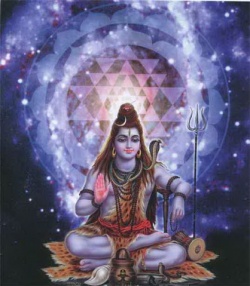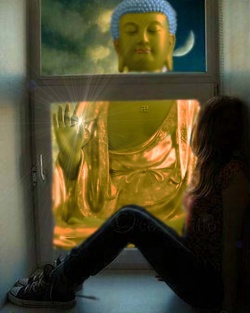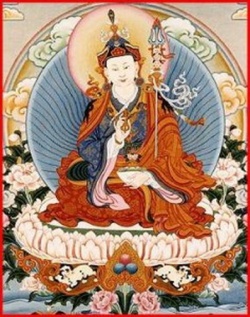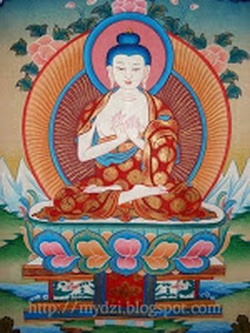Difference between revisions of "Manjushri is the Bodhisattva of Transcendent Wisdom"
(Created page with " Manjushri is the Bodhisattva of Transcendent Wisdom. The youthful {{Wiki|prince}} carries with his right hand the double--edged sword able to cut through illusi...") |
|||
| Line 1: | Line 1: | ||
| − | + | <nomobile>{{DisplayImages|1384|4382|3013|1396}}</nomobile> | |
| + | |||
| + | |||
| + | |||
| + | [[Manjushri]] is the [[Bodhisattva of Transcendent Wisdom]]. | ||
| + | |||
| + | The youthful {{Wiki|prince}} carries with his right hand the double--edged sword able to cut through [[illusion]] and with his left hand a blooming [[lotus]] that supports a volume of the [[Prajna-paramita]] [[Sutra]]. | ||
| + | |||
| + | He is depicted as a youth of sixteen years in [[order]] to convey the [[Buddhist]] [[insight]] that [[wisdom]] is not a [[matter]] of mere [[experience]] or years, but results from the [[cultivation]] of [[intellectual]] genius, which can penetrate directly to the bedrock of [[reality]]. | ||
| + | |||
| + | [[Wisdom]] is the most honored [[virtue]] in [[Buddhism]], called the Mother of all [[Buddhas]], since only [[wisdom]] makes possible the great [[bliss]] of total freedom from all [[suffering]] that is the goal of [[all living beings]]. | ||
| + | |||
| + | [[Thus]], [[Manjushri]] is one of the most important of all [[Buddhist deities]], the veritable [[god of wisdom]] and herald of {{Wiki|emancipation}}. | ||
| + | |||
| + | In the [[sutras]], [[Manjushri]] has a [[Pure Land]] in another [[universe]], wherein he [[manifests]] himself as the [[Buddha]] he actually is. | ||
| + | |||
| + | He is in fact a {{Wiki|perfect}} [[Buddha]] who [[vowed]] to [[emanate]] all over the [[universe]] as a [[Bodhisattva]] to put the hard questions to the [[Buddhas]] on the topics of [[voidness]], freedom, and the [[nature]] of the [[self]]. | ||
| + | |||
| + | But in the popular [[Tibetan]] [[imagination]], [[Manjushri]] has his [[earthly]] [[Pure Land]] at the [[magical]] [[Five Mountain Paradise]] (Ch. [[Wutaishan]]; T. [[Riwo Tsenga]]) in [[northeast]] [[China]], one of the most important [[pilgrimage]] places for [[Tibetan]], {{Wiki|Mongolian}}, and [[Chinese Buddhists]]. | ||
| + | |||
| + | [[Manjushri]] appears in several [[forms]] and different colours linking him to the families of [[Amitabha]], [[Akshobhya]] and so forth. In his most fundamental [[form]] he sits on a [[lion]] holding a sword in his right and the {{Wiki|manuscript}} of the [[Prajnaparamita]] in the left. | ||
| + | |||
| + | The flaming sword cuts through all [[intellectual]] and [[emotional]] entanglements thus revealing the [[transcendent wisdom]] of the [[Prajnaparamita]]. | ||
| − | |||
| − | |||
| − | |||
At times (like in the {{Wiki|present}} [[thangka]]), sword and [[book]] are placed on a [[lotus flower]]. | At times (like in the {{Wiki|present}} [[thangka]]), sword and [[book]] are placed on a [[lotus flower]]. | ||
| − | [[Intelligence]], [[memory]], [[wisdom]] and [[eloquence]] are all qualities that [[Manjushri]] bestows. His [[name]] is a [[compound]] of the words man-ju (meaning [[beautiful]], [[pleasing]], lovely, [[charming]], smooth) and [[shri]] (meaning [[brilliance]], [[splendour]], glory), and the connotations of | + | [[Intelligence]], [[memory]], [[wisdom]] and [[eloquence]] are all qualities that [[Manjushri]] bestows. |
| − | both these words convey perfectly the kind | + | |
| − | of [[intelligence]] and [[wisdom]] [[Manjushri]] | + | His [[name]] is a [[compound]] of the words man-ju (meaning [[beautiful]], [[pleasing]], lovely, [[charming]], smooth) and [[shri]] (meaning [[brilliance]], [[splendour]], glory), and the connotations of both these words convey perfectly the kind of [[intelligence]] and [[wisdom]] [[Manjushri]] himself {{Wiki|personifies}}. |
| − | himself {{Wiki|personifies}}. | + | |
| + | The main figure in this scroll has his hands in the gesture of turning- the- [[wheel of the dharma]]. | ||
| + | |||
| + | Being the {{Wiki|epitome}} of all the [[learning]] of the [[Buddha]], [[Manjushri]] is the leading proponent of the [[transmission of esoteric philosophy]]. | ||
| + | |||
| + | |||
| + | |||
| + | Directly above in the centre of the three figures of the top row rests [[Amitabha]], red in complexion, his hands in the gesture of [[meditation]]. | ||
| + | |||
| + | He is flanked on either side by red [[manifestations]] of [[Manjushri]], the one on the left in the [[vajra posture]] with sword and [[book]], the one on the right sitting on a [[lion]] with his left leg hanging down, his hands in the gesture of [[teaching]]. | ||
| + | |||
| + | |||
| + | |||
| + | |||
| + | The four [[manifestations]] to the left and right of the main figure are all of white complexion and sit in the [[diamond posture]] ([[vajrasa-na]]). | ||
| + | |||
| + | They can be divided into two groups: two of them have the right hand in the gesture of [[giving]] ([[varada mudra]]), while their left hands hold a {{Wiki|manuscript}} of the [[Prajnaparamita]]; the other two hold a sword in their right hand. | ||
| + | |||
| + | They are the [[consorts]] of this [[Arapacha-na Manjushri]], representing "[[i-a-pa-cha-ria]]", the-final four {{Wiki|syllables}} of [[Manjushri's mantra]], while the main [[deity]], [[Manjushri]], represents the first {{Wiki|syllable}} "a", from which he himself originates. | ||
| + | |||
| + | He is as [[beautiful]] as one [[sadhana]] describes him: "...resplendent like the [[full moon]], a [[smile]] lingering on his face, decked in a rich variety of prin-cely ornaments". | ||
| + | |||
| + | |||
| + | |||
| + | The bottom row of figures has White [[Prajnaparamita]] on the left, carrying a {{Wiki|manuscript}} of the [[Prajnaparamita Sutra]] on two [[lotus flowers]] that grow out of her hands, while her hands themselves are in the gesture of [[teaching]]. | ||
| + | |||
| + | [[Prayers]] addressed to her enhance [[wisdom]], increase [[intelligence]] and promote [[discernment]]. | ||
| + | |||
| + | She {{Wiki|personifies}} the [[transcendent wisdom]] propounded in the [[books]] she carries. | ||
| + | |||
| + | The centre figure in the bottom row is a white [[Manjushri]], while in the right corner we see a white [[Sarasvati]] with her [[vina]] (lute), the [[goddess of learning]], [[poetry]], [[music]] and [[eloquence]]. | ||
| + | |||
| + | |||
| + | |||
| + | As [[transcendent wisdom]] personified and [[Vagishvari]], [[Lord of Speech]] (i.e. [[learning]]), the [[mahabodhisattva]] [[Manjushri]] plays an important role in all [[Buddhist traditions]] throughout history. | ||
| + | |||
| + | In the [[Lotus Sutra]] his fellow [[bodhisattva Maitreya]] exhorts him: "Remove our [[doubts]]! The four kinds of {{Wiki|devotees}} are looking up with [[joy]] at you and me..." The [[Shurangama Sutra]] declares him "[[absolute]] as such, to be neither asserted nor negated". | ||
| + | |||
| + | Together with [[Samantabhadra]] he is also the main [[bodhisattva]] of the [[Avatamsaka Sutra]]. An entire [[tantra]] is devoted to him: the [[Manjushri Mula Kalpa]]. | ||
| + | |||
| + | According to the [[Zen tradition]] he attends upon [[Buddha Shakyamuni]] together with [[mahabodhisattva]] [[Samantabhadra]]. He is mentioned in the [[Smaller Sukhavati Vyuha]] and in the [[Guhyasamaja Tantra]]. | ||
| + | |||
| + | And this is by no means all; we could go on enumerating text after texts, such is the importance of [[Manjushri]] for the [[Buddhist tradition]]. | ||
| − | |||
| − | |||
| − | The | + | The [[Svayambhu Purana]] relates that [[Manjushri]] came from [[Wu Taishan Mountain]] in [[China]]. |
| − | + | After arriving in [[Svayambhunath]] in [[Nepal]] he lifted his sword and clove the [[mountains]], so that the lake's waters gushed out. | |
| − | + | [[Thus]] the {{Wiki|fertile}} and lovely [[Kathmandu valley]] was formed. According to {{Wiki|Chinese}} [[tradition]], [[Manjushri]] was assigned the [[duty]] of turning the [[Wheel of the Dharma]] for the benefit of the {{Wiki|Chinese people}} and he chose [[Wu Taishan mountain]] as his abode. | |
| − | The [[ | + | The famous [[pilgrim]] [[I-tsing]] notes during his travels through {{Wiki|Southeast Asia}} and [[India]] (671-695 A.D.) that the {{Wiki|Indians}} [[thought]] [[Manjushri]] to be [[teaching]] in [[China]] at that [[time]]. |
| − | [[Thus]] the scroll without exception contains [[deities]] that personify and bestow ordinary as well as [[transcendent wisdom]]. They all belong to the category of Prajna-deities, as [[Panchen | + | [[Thus]] the scroll without exception contains [[deities]] that personify and bestow ordinary as well as [[transcendent wisdom]]. They all belong to the category of [[Prajna-deities]], as [[Panchen Phyogla Namgyal]] (1781-1952) decided to call them in his major work on [[Buddhist iconography]]. |
{{R}} | {{R}} | ||
[http://www.abuddhistlibrary.com/Buddhism/A%20-%20Tibetan%20Buddhism/Subjects/Tantra/Practices-%20%28Sadhanas%20and%20commentaries%29/Manjushri/About%20Manjushri/Manjushri.htm] | [http://www.abuddhistlibrary.com/Buddhism/A%20-%20Tibetan%20Buddhism/Subjects/Tantra/Practices-%20%28Sadhanas%20and%20commentaries%29/Manjushri/About%20Manjushri/Manjushri.htm] | ||
[[Category:Manjushri]] | [[Category:Manjushri]] | ||
Latest revision as of 05:18, 23 October 2015
Manjushri is the Bodhisattva of Transcendent Wisdom.
The youthful prince carries with his right hand the double--edged sword able to cut through illusion and with his left hand a blooming lotus that supports a volume of the Prajna-paramita Sutra.
He is depicted as a youth of sixteen years in order to convey the Buddhist insight that wisdom is not a matter of mere experience or years, but results from the cultivation of intellectual genius, which can penetrate directly to the bedrock of reality.
Wisdom is the most honored virtue in Buddhism, called the Mother of all Buddhas, since only wisdom makes possible the great bliss of total freedom from all suffering that is the goal of all living beings.
Thus, Manjushri is one of the most important of all Buddhist deities, the veritable god of wisdom and herald of emancipation.
In the sutras, Manjushri has a Pure Land in another universe, wherein he manifests himself as the Buddha he actually is.
He is in fact a perfect Buddha who vowed to emanate all over the universe as a Bodhisattva to put the hard questions to the Buddhas on the topics of voidness, freedom, and the nature of the self.
But in the popular Tibetan imagination, Manjushri has his earthly Pure Land at the magical Five Mountain Paradise (Ch. Wutaishan; T. Riwo Tsenga) in northeast China, one of the most important pilgrimage places for Tibetan, Mongolian, and Chinese Buddhists.
Manjushri appears in several forms and different colours linking him to the families of Amitabha, Akshobhya and so forth. In his most fundamental form he sits on a lion holding a sword in his right and the manuscript of the Prajnaparamita in the left.
The flaming sword cuts through all intellectual and emotional entanglements thus revealing the transcendent wisdom of the Prajnaparamita.
At times (like in the present thangka), sword and book are placed on a lotus flower.
Intelligence, memory, wisdom and eloquence are all qualities that Manjushri bestows.
His name is a compound of the words man-ju (meaning beautiful, pleasing, lovely, charming, smooth) and shri (meaning brilliance, splendour, glory), and the connotations of both these words convey perfectly the kind of intelligence and wisdom Manjushri himself personifies.
The main figure in this scroll has his hands in the gesture of turning- the- wheel of the dharma.
Being the epitome of all the learning of the Buddha, Manjushri is the leading proponent of the transmission of esoteric philosophy.
Directly above in the centre of the three figures of the top row rests Amitabha, red in complexion, his hands in the gesture of meditation.
He is flanked on either side by red manifestations of Manjushri, the one on the left in the vajra posture with sword and book, the one on the right sitting on a lion with his left leg hanging down, his hands in the gesture of teaching.
The four manifestations to the left and right of the main figure are all of white complexion and sit in the diamond posture (vajrasa-na).
They can be divided into two groups: two of them have the right hand in the gesture of giving (varada mudra), while their left hands hold a manuscript of the Prajnaparamita; the other two hold a sword in their right hand.
They are the consorts of this Arapacha-na Manjushri, representing "i-a-pa-cha-ria", the-final four syllables of Manjushri's mantra, while the main deity, Manjushri, represents the first syllable "a", from which he himself originates.
He is as beautiful as one sadhana describes him: "...resplendent like the full moon, a smile lingering on his face, decked in a rich variety of prin-cely ornaments".
The bottom row of figures has White Prajnaparamita on the left, carrying a manuscript of the Prajnaparamita Sutra on two lotus flowers that grow out of her hands, while her hands themselves are in the gesture of teaching.
Prayers addressed to her enhance wisdom, increase intelligence and promote discernment.
She personifies the transcendent wisdom propounded in the books she carries.
The centre figure in the bottom row is a white Manjushri, while in the right corner we see a white Sarasvati with her vina (lute), the goddess of learning, poetry, music and eloquence.
As transcendent wisdom personified and Vagishvari, Lord of Speech (i.e. learning), the mahabodhisattva Manjushri plays an important role in all Buddhist traditions throughout history.
In the Lotus Sutra his fellow bodhisattva Maitreya exhorts him: "Remove our doubts! The four kinds of devotees are looking up with joy at you and me..." The Shurangama Sutra declares him "absolute as such, to be neither asserted nor negated".
Together with Samantabhadra he is also the main bodhisattva of the Avatamsaka Sutra. An entire tantra is devoted to him: the Manjushri Mula Kalpa.
According to the Zen tradition he attends upon Buddha Shakyamuni together with mahabodhisattva Samantabhadra. He is mentioned in the Smaller Sukhavati Vyuha and in the Guhyasamaja Tantra.
And this is by no means all; we could go on enumerating text after texts, such is the importance of Manjushri for the Buddhist tradition.
The Svayambhu Purana relates that Manjushri came from Wu Taishan Mountain in China.
After arriving in Svayambhunath in Nepal he lifted his sword and clove the mountains, so that the lake's waters gushed out.
Thus the fertile and lovely Kathmandu valley was formed. According to Chinese tradition, Manjushri was assigned the duty of turning the Wheel of the Dharma for the benefit of the Chinese people and he chose Wu Taishan mountain as his abode.
The famous pilgrim I-tsing notes during his travels through Southeast Asia and India (671-695 A.D.) that the Indians thought Manjushri to be teaching in China at that time.
Thus the scroll without exception contains deities that personify and bestow ordinary as well as transcendent wisdom. They all belong to the category of Prajna-deities, as Panchen Phyogla Namgyal (1781-1952) decided to call them in his major work on Buddhist iconography.



